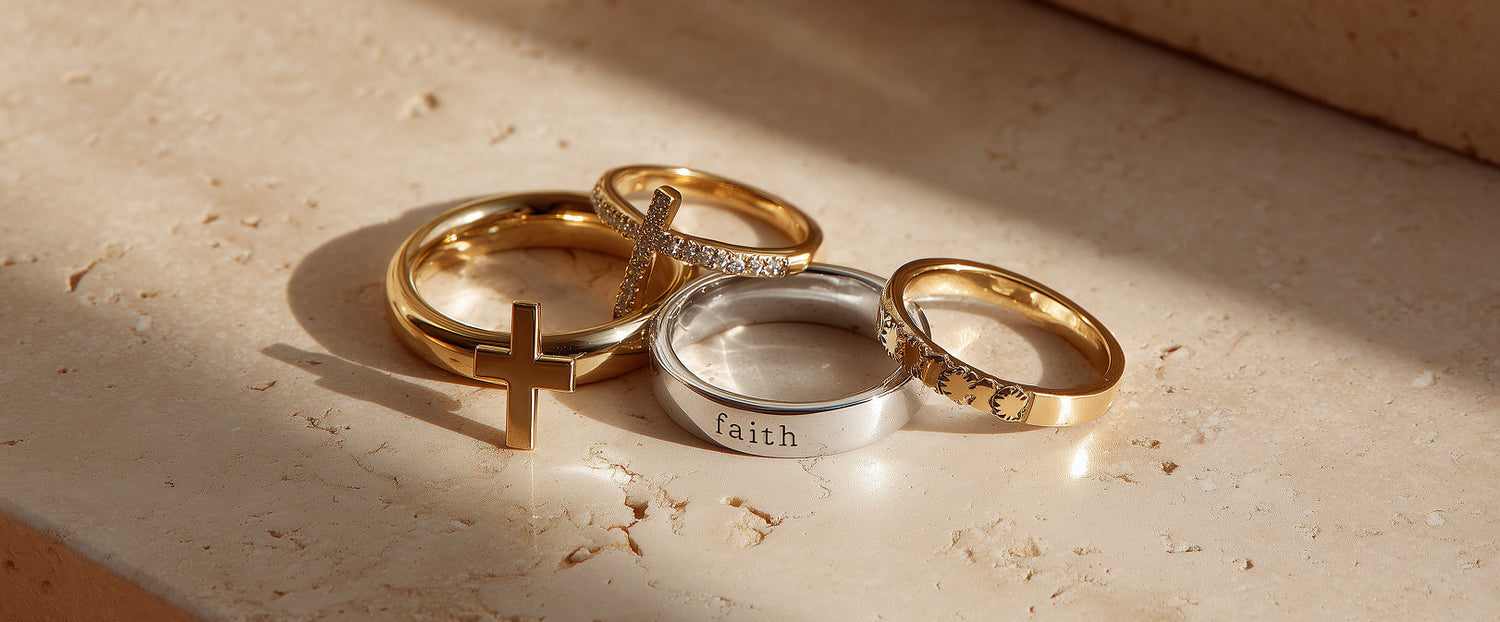
WWJD Bracelet: The Four Letters Guiding a New Generation
Share
It’s not just a bracelet. It’s a bold, quiet revolution.
WWJD — What Would Jesus Do? — a phrase that once echoed through youth groups and church camps — is rising again. But this time, it’s different.
For a new generation craving truth in a world of contradictions, WWJD isn’t nostalgic. It’s necessary. It’s not about wearing a trend. It’s about living a question — one that reshapes how we respond to conflict, temptation, culture, and even ourselves.
This isn’t a comeback for the sake of fashion. It’s a return to something deeper: a faith that’s worn, visible, and intentional. A reminder to live like Jesus not just in belief, but in behavior.
And for many Gen Z believers, this little bracelet is becoming their boldest act of resistance.

Where Did the WWJD Bracelet Come From?
Before it was a global symbol, before it showed up on TikTok wrists and minimalist jewelry drops, WWJD started with a youth pastor and a burden.
In 1989, Janie Tinklenberg, a leader at a small church in Michigan, wanted to help her teens remember one thing throughout their week: to live like Jesus would. Inspired by the 1896 novel In His Steps by Charles Sheldon — which first posed the question “What would Jesus do?” — she printed the letters WWJD on simple fabric christian bracelets and handed them out.
She didn’t expect a movement. But it spread like wildfire.
By the mid-90s, WWJD bracelets had become a Christian staple — worn by millions across denominations. It wasn’t flashy or high-tech. But somehow, it worked. Every time a student faced a choice — peer pressure, gossip, temptation, fear — that tiny bracelet whispered a question that reshaped their response.
For a while, it was everywhere. But like many cultural waves, it faded.
And yet… not fully. Because truth never expires. And what’s real always returns.
Today, the WWJD bracelet is reemerging — not as merch, but as a manifesto. Not as a trend, but as a quiet resistance to the chaos of modern life.
The Theology Behind the Thread
WWJD isn’t about guessing. It’s about knowing.
The question only matters if we care enough to learn the answer.
To wear the bracelet is to carry a quiet challenge:
Will I slow down long enough to ask? Will I open Scripture long enough to hear?
Because Jesus didn’t just say “believe in Me” — He said “follow Me.” That means we’re not just admiring His divinity from a distance — we’re stepping into His way of living:
How He spoke. How He paused. How He forgave. How He ate with sinners. How He prayed in silence. How He healed gently. How He flipped tables in holy rage.
WWJD isn’t passive. It’s powerful.
The deeper theology of this tiny phrase is imitation rooted in revelation.
It’s not about personality mirroring — it’s about spiritual formation. We don't copy Him to perform; we follow Him to transform. As Paul said, “Imitate me as I imitate Christ” (1 Corinthians 11:1). This is the ancient tradition of becoming more like the One we love.
When you ask “What Would Jesus Do?”, you’re not trying to impress Him —
you’re inviting Him to live through you.
Why Gen Z Is Reclaiming WWJD — And Making It Cool Again
It’s not vintage. It’s not ironic. It’s intentional.
Gen Z grew up in a world of chaos: climate anxiety, digital overload, cultural breakdown, and a thousand empty promises. They're over noise. Over perfection. Over performative religion.
They want something real. Something rooted.
And what could be more rebellious — more countercultural — than quietly asking, “What would Jesus do?” at the moment the world says “Do what you want”?
That’s why the WWJD bracelet is showing up again — on teens in prayer circles and creatives in recording studios, on athletes, podcasters, and poets. But it’s not flashy. It’s subtle. Minimalist. Understated. A conversation starter — or a quiet reminder.
Gen Z is reclaiming Christianity not as a culture war—but as a walk with Christ.
They don’t want megachurch performance. They want depth. Authenticity. They want to feel God in daily life. And WWJD gives language to that hunger. It’s a discipleship tool disguised as an accessory.
Not a brand. A belief.
Not a slogan. A question.

WWJD in the Wild: Real-Life Stories from People Who Wear It
“I was about to text something I knew I’d regret… then I saw the bracelet.”
— Nico, 19
“I bought it after losing my brother. I needed something to help me breathe again.”
— Grace, 22
“I don’t even talk about my faith much, but people ask about the bracelet. It’s helped me start conversations I never would’ve had otherwise.”
— Jeremiah, 26
WWJD isn’t just about you.
It’s about who notices. Who asks. Who God nudges through one simple string of letters.
That’s the ripple effect of revival.
From Accessory to Accountability: Wearing Faith with Intention
WWJD isn't about perfection. It's about direction.
Every time you slip it on, you're saying:
“I want to try again today. I want to walk different. I want to choose love, not ego.”
And when it becomes habit, your reactions shift.
Your conversations soften.
Your posture changes — not just spiritually, but physically.
It’s not just an accessory. It’s accountability on your wrist.
A daily whisper from Heaven: There’s another way.
WWJD x Lumencross: Redefining What It Means to Wear Your Faith
At Lumencross, we don’t just design christian jewelry.
We design faith companions — small pieces of sacred daily armor that remind you who you are and whose you are.
Our WWJD line is:
Made for movement — lightweight, durable, and sweat-proof for everyday wear
Crafted with intention — stainless steel, woven bands, and scriptural detail
Rooted in mission — proceeds fund digital Bibles and creative Christian outreach
Because we believe every believer deserves a reminder close at hand —
Not just of what Jesus would do.
But that He is with you as you do it.
Celebrities Who Made It Known (and Cool Again)
WWJD isn't just for youth groups. It’s been seen on the wrists of some of culture’s biggest names:
-
Justin Bieber was spotted wearing one during his spiritual reawakening phase.
-
Steph Curry has cited it as part of his faith-focused mindset on and off the court.
-
Mark Wahlberg, in interviews about his Catholic faith, has worn WWJD bracelets as quiet reminders.
-
Even Lenny Kravitz rocked a woven faith bracelet with WWJD during press tours.
When stars wear symbols of belief—not for PR, but for personal grounding—it signals something deeper. WWJD isn’t just back. It never left.
How to Wear It, Mean It, and Live It
A WWJD bracelet isn’t magic.
It doesn’t make your decisions for you.
But it does something sacred — it interrupts autopilot.
In the middle of an argument, your fingers feel the band.
At a crossroad, a moment of fear, a social scroll spiral… there it is again.
Four letters. One holy pause.
WWJD isn’t a guilt-trip — it’s an invitation.
Wear it with jeans. With a suit. With nail polish chipped or perfect. In high school or on a plane. It’s not for a type. It’s for the Christ-following soul who still wrestles with daily choices.
At Lumencross, we carry minimalist, modern WWJD bracelets that fit your life — and your faith. Some in leather. Some in stainless steel. Some you can pass to a friend in crisis.
Because WWJD is more than a bracelet.
It’s a way of being. A question worth keeping close.
A practice of surrender disguised as style.
This time, it’s not a trend. It’s a comeback for the Kingdom.



